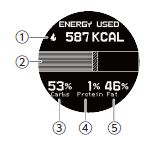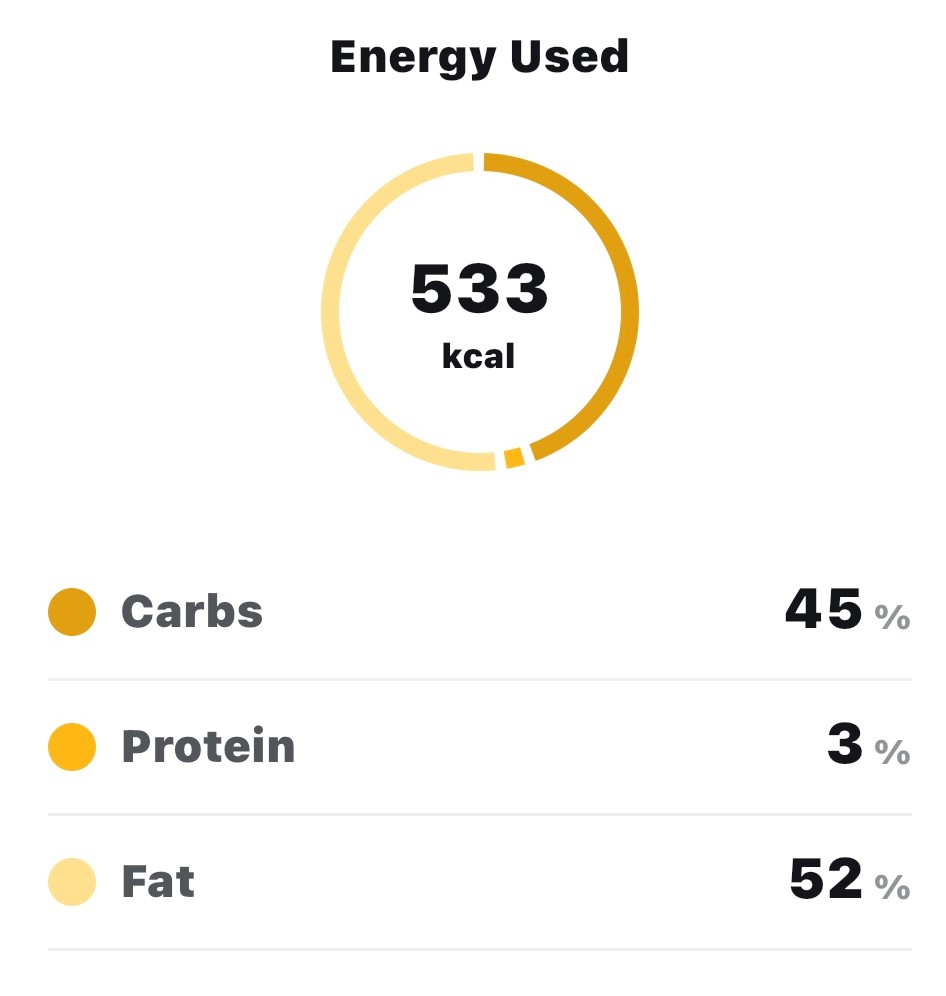
ENERGY USED
The energy used breakdown shows how much of different energy sources (fats, carbohydrates and proteins) you used during your session. They are illustrated as percentages of your total calorie consumption.
During physical activity, your body uses carbohydrates and fat as its main sources of energy. The higher your training intensity, the more carbs it uses in proportion to fat, and vice versa. The role of protein is usually quite small, but during high intensity activity and during long sessions your body can use about 5 to 10 % of its energy from protein. When experiencing glycogen depletion, protein consumption is higher.
The use of different energy sources is calculated based on your heart rate, but your physical settings are also taken into account. These include your age, gender, height, weight, maximum heart rate, resting heart rate, VO2max, aerobic threshold and anaerobic threshold. It's important that you've set these settings as precisely as possible, so you'll get the most accurate energy source consumption data.
On your watch the energy nutrients breakdown can be viewed in the training summary right after your session. You can see how much of each nutrient you've used during your session in percentages. Note that when planning your post-session nutrition, the percentages of carbohydrates, fat and protein consumed during exercise shouldn’t be used as a guideline. This is because carbs, fat and protein play different roles as energy sources than as a nutrients on your plate. For example, protein doesn’t play a big role during exercise, but it is an important nutrient in your daily intake.

① Calories burned during measurement period
② Energy Used Graph
③ Carbohydrate percentage
④ Protein percentage
⑤ Fat percentage

・HOW TO BENEFIT FROM KNOWING HOW MUCH ENERGY
SOURCES YOU USED
Seeing how much of different the energy sources you used during your session allows you to learn how different intensities affect your energy usage. You can also spot how the main energy source can change during a long session. Knowing your energy nutrients is also useful if you’re looking to improve your body’s ability to utilize body fat as an energy source with long duration low intensity training.
Scientific background
The algorithm estimates the amount of carbohydrates, proteins and fats of the total kilocalories consumed during physical exertion. It assumes that the availability of glycogen as a source for carbohydrates is limited but that the availability of fat and protein is unlimited. It also assumes that glycogen stores are full at the start of the training session. The relative consumption rates between carbohydrates, proteins and fat depend on exercise intensity measured with heart rate, and the glycogen available. Resting heart rate, aerobic heart rate threshold, anaerobic heart rate threshold and maximum heart rate have a significant effect on the relative consumption rate of carbohydrates, proteins and fat at a certain heart rate.
The model was validated by simulating multiple possible exercise types with multiple artificial physical background parameters representing both males and females of various ages, heights, weights and with training backgrounds ranging from occasional trainers to pro athletes. Parameter combinations with exceptionally low or high body mass indexes were excluded. The reference values for the relative energy consumption were defined by a sports nutrition specialist based on a review of various scientific papers and textbooks and practical knowledge. The results of the validation showed a good correlation between the model and the expected fractions for fat, carbohydrates and proteins.
Source: Polar Research
Polar science
